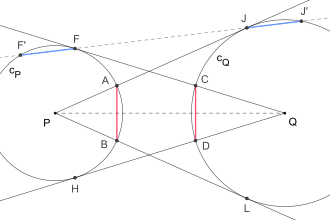
theorem variation, blue chords are of equal length
The eyeball theorem is a statement in elementary geometry about a property of a pair of disjoined circles.
More precisely it states the following: [1]
- For two nonintersecting circles and centered at and the tangents from P onto intersect at and and the tangents from Q onto intersect at and . Then .
The eyeball theorem was discovered in 1960 by the Peruvian mathematician Antonio Gutierrez. [2] However without the use of its current name it was already posed and solved as a problem in an article by G. W. Evans in 1938. [3] Furthermore Evans stated that problem was given in an earlier examination paper. [4]
A variant of this theorem states, that if one draws line in such a way that it intersects for the second time at and at . Then, it turns out that . [3]
There are some proofs for Eyeball theorem, one of them show that this theorem is a consequence of the Japanese theorem for cyclic quadrilaterals. [5]
See also
References
- ^ Claudi Alsina, Roger B. Nelsen: Icons of Mathematics: An Exploration of Twenty Key Images. MAA, 2011, ISBN 978-0-88385-352-8, pp. 132–133
- ^ David Acheson: The Wonder Book of Geometry. Oxford University Press, 2020, ISBN 9780198846383, pp. 141–142
- ^ a b José García, Emmanuel Antonio (2022), "A Variant of the Eyeball Theorem", The College Mathematics Journal, 53 (2): 147-148.
- ^ Evans, G. W. (1938). Ratio as multiplier. Math. Teach. 31, 114–116. DOI: https://doi.org/10.5951/MT.31.3.0114.
- ^ The Eyeball Theorem at cut-the-knot.org
Further reading
- Antonio Gutierrez: Eyeball theorems. In: Chris Pritchard (ed.): The Changing Shape of Geometry. Celebrating a Century of Geometry and Geometry Teaching. Cambridge University Press, 2003, ISBN 9780521531627, pp. 274–280
External links
- Weisstein, Eric W. "Eyeball Theorem". MathWorld.
- Eyeball Theorem at Geometry from the Land of the Incas

theorem variation, blue chords are of equal length
The eyeball theorem is a statement in elementary geometry about a property of a pair of disjoined circles.
More precisely it states the following: [1]
- For two nonintersecting circles and centered at and the tangents from P onto intersect at and and the tangents from Q onto intersect at and . Then .
The eyeball theorem was discovered in 1960 by the Peruvian mathematician Antonio Gutierrez. [2] However without the use of its current name it was already posed and solved as a problem in an article by G. W. Evans in 1938. [3] Furthermore Evans stated that problem was given in an earlier examination paper. [4]
A variant of this theorem states, that if one draws line in such a way that it intersects for the second time at and at . Then, it turns out that . [3]
There are some proofs for Eyeball theorem, one of them show that this theorem is a consequence of the Japanese theorem for cyclic quadrilaterals. [5]
See also
References
- ^ Claudi Alsina, Roger B. Nelsen: Icons of Mathematics: An Exploration of Twenty Key Images. MAA, 2011, ISBN 978-0-88385-352-8, pp. 132–133
- ^ David Acheson: The Wonder Book of Geometry. Oxford University Press, 2020, ISBN 9780198846383, pp. 141–142
- ^ a b José García, Emmanuel Antonio (2022), "A Variant of the Eyeball Theorem", The College Mathematics Journal, 53 (2): 147-148.
- ^ Evans, G. W. (1938). Ratio as multiplier. Math. Teach. 31, 114–116. DOI: https://doi.org/10.5951/MT.31.3.0114.
- ^ The Eyeball Theorem at cut-the-knot.org
Further reading
- Antonio Gutierrez: Eyeball theorems. In: Chris Pritchard (ed.): The Changing Shape of Geometry. Celebrating a Century of Geometry and Geometry Teaching. Cambridge University Press, 2003, ISBN 9780521531627, pp. 274–280
External links
- Weisstein, Eric W. "Eyeball Theorem". MathWorld.
- Eyeball Theorem at Geometry from the Land of the Incas












